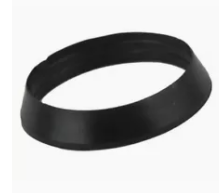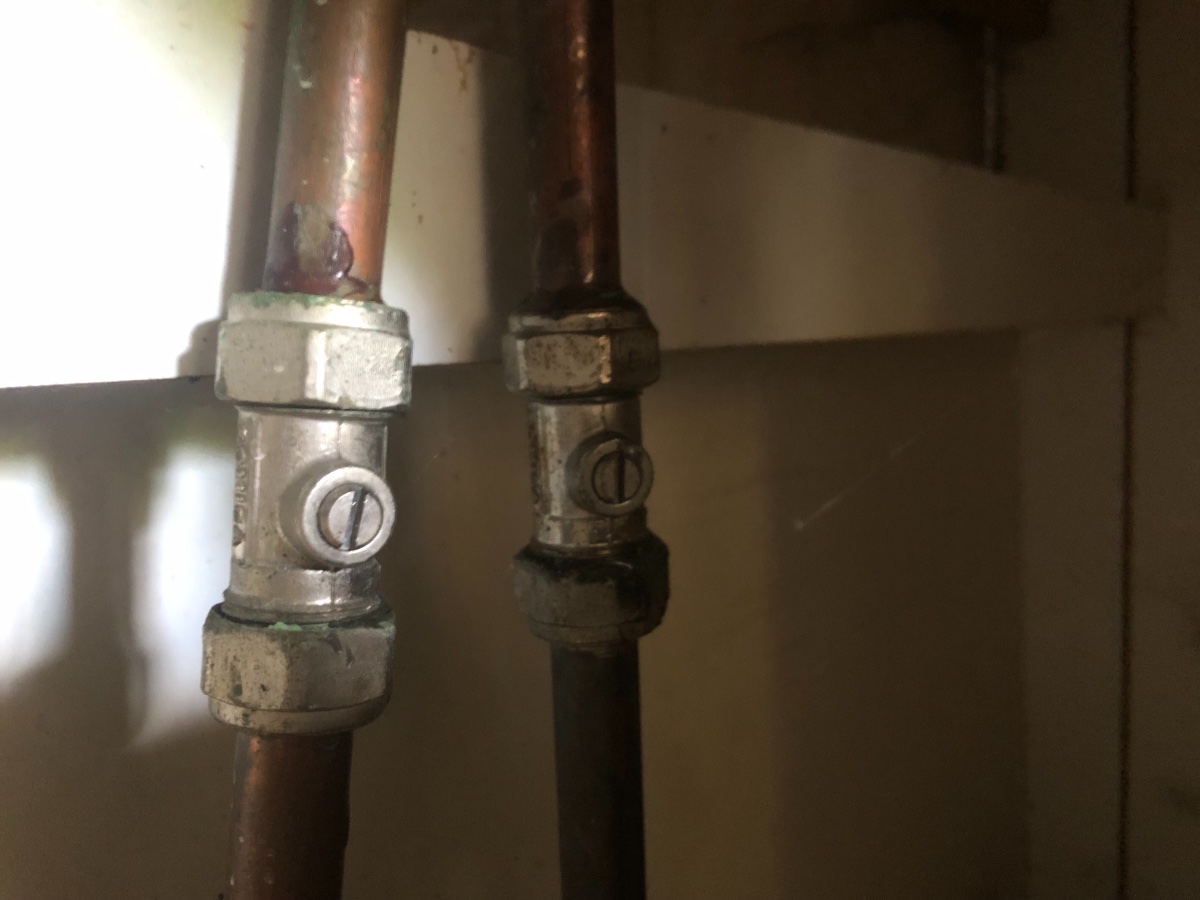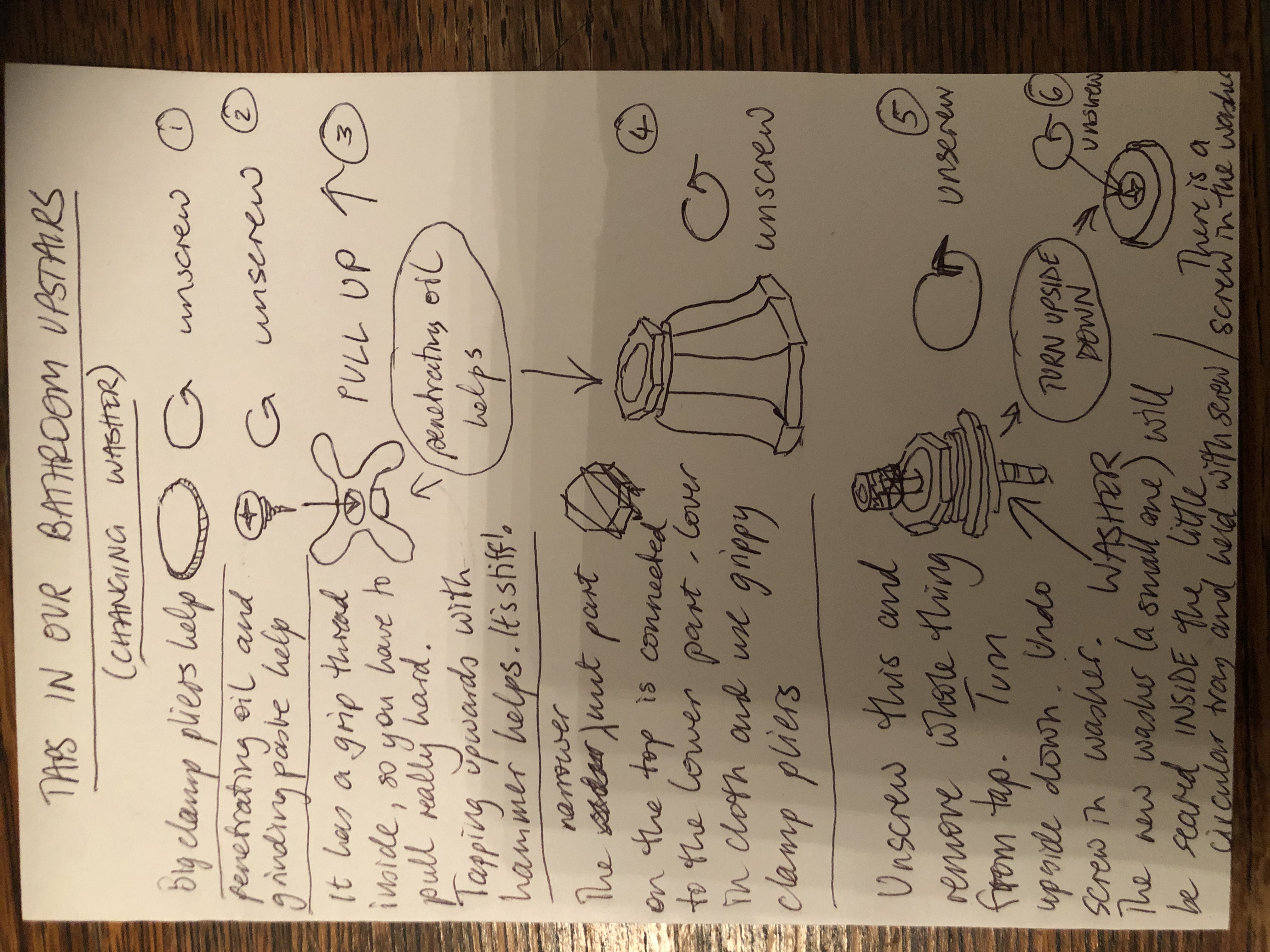Plumbing
Contents of this page:
Fixing leaks to pipes under sink
- https://homeguides.sfgate.com/fix-pipes-come-loose-under-sink-31304.html
- https://www.hunker.com/13417096/how-to-install-slip-joint-washers-in-plumbing
- https://youtu.be/1b0asFPDzfA
- Notes:
- you need a rubber gasket (= washer in UK)
- for your slip joint nut (= compression joint in UK)
- 1.5” / 40mm
- and a nut
- and maybe a length of pipe (also 1.5” / 40mm).
- What we did:
- We bought a “cistern flush pipe coupling rubber conical washer seal” (see photo) from eBay, and used it to replace the previous one, which was rounded and had a uniform width (instead of tapered). This fixed the loose joint under our kitchen sink (early 2021).

- We also bought one of these (see pic), which was a “McAlpine T12A-3 1½” BSP Coupler White 40mm x 40mm” from Screwfix. The diagram shows how it would have worked if we’d needed it, but actually the replacement washer seems to have done the job.
- We bought a “cistern flush pipe coupling rubber conical washer seal” (see photo) from eBay, and used it to replace the previous one, which was rounded and had a uniform width (instead of tapered). This fixed the loose joint under our kitchen sink (early 2021).
Installing a new kitchen mixer tap
How to attach the pipes
When the pipes look like this…

- Extra advice based on experience (see also advice from friends below):
- This video is really good
- Turn the water off at source first, in case of error
- Make sure you clamp the bottom nut to hold everything still while you turn the top nut
- The olives may not come off and you may need to cut the pipe - in which case you can use a small tube cutter - only cost me £10 and worked like magic!
- Advice from friends:
- “Turn the screw 90 degrees and it’ll isolate the valve, then you can detatch the top bit. They’re called isolator valves if you need to Google.”
- “No welding required, those are compression joints and the bit in the middle is a valve. Turn the valve with a screwdriver to turn off water to the pipes coming off the tap, loosen the nut and the pipe should come out with that bronze bit (called an olive) round the outside near the end of the pipe. It’s possible whoever fit it also put some tape/putty other stuff round the joint but you really don’t need that with compression joints. If the olive won’t come off the pipe or it’s a bit bent then just buy some more, cost next to nothing. “
- “the key lesson with them is to not over-tighten when you’re doing it back up.”
- “it’s an isolator valve with compression joints on the ends. Depending on how your new tap fits it might need that same copper pipe into it or it might have flexi pipes that just screw onto the top of the isolator valve, no olives or other bits needed. “
- “Also a top tip - If you are installing a tap from Grohe, Germans use valves that are based on metric rather than imperial measurements and are ever so slightly differently sized from standard UK plumbing so you need an adaptor. Fine for going into compression joints, not fine for screwing onto things like isolator valves.”
How to get good water pressure from a tap
The things that make a difference are:
-
- Your water pressure
- Good water pressure is 15 litres per minute or more
- Measure your water pressure by pouring water into a jug from your tap for exactly 6 seconds
- Multiply the amount of water collected by 10 to get litres per minute
- You will need a jug which can hold at least 2 litres
- If using a 1-litre jug, only do it for 3 seconds and then multiply by 20
- 10 litres per minute is 1 bar
- Your water pressure
-
- The flow rate coming from the tap
- decent sites (this one is the best I could find) will advertise the flow rate, ideally according to your water pressure. If this info is not published, prob best not to buy the tap!
- This is where I bought my replacement tap
- BUT when it arrived, it not only had a narrow flexible supply pipe, it was even narrower than the previous one!
- I still haven’t installed it yet, over a year later (Jan ‘23). I was so depressed / stressed by the whole thing, I couldn’t face further disappointment. - A good flow rate is 11 lpm (litres per minute) or more. Anything less than this will probably be frustratingly slow - particularly when doing things like filling kettles or running baths. - This will be determined by things like the bore (diameter) of the feed pipe that connects from your pipes to your tap
- The flow rate coming from the tap
Note: It seems v hard to get decent water pressure from cheap taps. I ended up spending £150 on a replacement tap (which seems like a lot to me) because the cheaper ones were either low pressure or didn’t advertise flow rate, which meant I had to assume they would be low. BUT when the £150 replacement arrived (around Dec ‘21), it not only had a narrow flexible supply pipe, it was even narrower than the previous one! I was fully depressed by the whole thing and it has been sitting in a box ever since. I can’t face the stress of installing it only to find out it’s yet again not what I want.
Here’s the original question I posted on a plumbing forum (for Clare: login details are in 1pw):
Hi
I bought a simple kitchen mixer tap from Amazon, plumbed it in no problem. It works… but the water pressure is lower than it used to be. It now takes ages to fill the kettle. We are finding ourselves filling the kettle from the bathroom tap because we get impatient waiting for the kitchen tap! It used to have high water pressure with the previous tap, and all the other taps in the house have high water pressure.
I thought maybe the problem was due to the fact that the flexible metal hose attachment which joins onto our internal copper piping is a narrower diameter than the copper piping. So I bought another one, and the manufacturers assured me it contained standard fittings which should work with standard UK plumbing and give decent water pressure… but when it arrived it had the same fittings as the existing one - so I didn’t bother trying to install it, I just sent it back.
The problem is, I don’t know if I’m right that the problem is caused by the width of the pipe. Can you give me advice on how I tell whether I am buying the right product or not to get decent water pressure?
Here is the product I sent back because it seemed like the pipe was too narrow: https://www.victorianplumbing.co.uk/modern-mono-kitchen-tap-with-pull-out-rinser-chrome
Here is the product we currently have installed: https://smile.amazon.co.uk/gp/product/B0793N2D1T/ref=ppx_yo_dt_b_search_asin_title?ie=UTF8&psc=1
Attached is a photo of the fittings below our sink - you can see the flexible pipes that come with the tap in the top half, and the original copper pipes in the bottom half.
Hoping someone can help!
Cheers Clare.

Changing a washer on an old tap
- The old kind that our original taps were: Change a tap washer
- The newer kind that our current taps are: Replacing a tap washer & using a reseating tool
- I couldn’t undo the screw so I ended up following this advice.
- The whole job was awkward. Here are the notes I wrote afterwards, and a picture of the tap itself.


